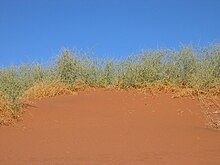Acanthosicyos
| Acanthosicyos | |
|---|---|

| |
| Acanthosicyos in situ | |
| Scientific classification | |
| Kingdom: | Plantae |
| Clade: | Tracheophytes |
| Clade: | Angiosperms |
| Clade: | Eudicots |
| Clade: | Rosids |
| Order: | Cucurbitales |
| Family: | Cucurbitaceae |
| Subfamily: | Cucurbitoideae |
| Tribe: | Benincaseae |
| Genus: | Acanthosicyos Welw. ex Benth. & Hook.f. |
| Species | |
| Synonyms | |
|
Acanthosicyus Post & Kuntze, orth. var. | |
Acanthosicyos is a genus of thorny shrubs of the botanical family Cucurbitaceae, subfamily Cucurbitoideae.[1] The genus name derives from the Greek words "akantha" for thorn and "sykios" for cucumber or gourd.[2]
Species
Endemic to the Namib Desert in Africa, this genus is represented by two known species including Acanthosicyos horridus, the nara melon, an important food plant in its native range.
| Image | Name | Distribution | Description |
|---|---|---|---|
 |
Gemsbok cucumber (Acanthosicyos naudinianus) | western Botswana, eastern Namibia and northern South Africa | trailing herb |
 |
Nara melon (Acanthosicyos horridus) | Namib Desert but predominantly found within a narrow coastal strip in Namibia | It is almost exclusively found in sand dunes that have subterranean water supplies available to the plant. The nara plant is leafless, the modified stems and spines serve as the photosynthetic "organs" of the plant. |
Both the Nara and the Gemsbok Cucumber are edible; however, eating unripe fruit is highly inadvisable due to the presence of chemicals which "burn" the throat and esophagus. The bushmen of the Kalahari eat the Gemsbok Cucumber after it has been roasted in a fire for a couple of hours. This cooking renders the "burning" chemicals harmless; even if the cooked pulp is still slightly bitter, the Bushman seem to relish eating them, sucking out the contents and either spitting out or chewing up the plentiful seeds.
References
- ^ Lithwick, Harvey; Bruins, Hendrik J. (1998). The Arid Frontier: Interactive Management of Environment and Development. Boston: Kluwer Academic Publishers. ISBN 978-0-7923-4227-4.
- ^ Umberto Quattrocchi (1999). CRC World Dictionary of Plants Names: Common Names, Scientific Names, Eponyms, Synonyms, and Etymology. Boca Raton: CRC Press. ISBN 978-0-8493-2675-2.
